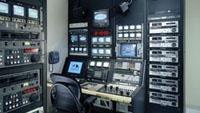Morgan Stanley replicates World Trade Center facility
Morgan Stanley
replicates
World Trade Center facility

When Morgan Stanley began planning the communications center for its new headquarters in Purchase, NY, the company contacted The Systems Group (TSG) to replicate the original facility it had designed and built four years earlier in NYC’s World Trade Center. The financial group needed to be capable of broadcasting news and interviews internally among the staff, and to affiliates and broadcasters worldwide.
The centerpiece of the facility is a noise-isolated production studio. A deep cut through the concrete floor around the entire studio acoustically decouples it from traffic in the busy corridors on three sides. Four Ikegami HL-45AW digital triax cameras can be connected to the control room from any of four broadcast service panels (BSPs) located on different walls of the studio. Using a TSG custom triax patch panel that unites camera trunks from around the building, the signals connect to a Thomson Grass Valley Zodiac switcher. The 2.5M/E switcher has a Dveous/MX dual twin effects package. The team selected Pinnacle FXDeko II and Thunder for CG and still store, and an Ultimate II for chroma key effects.
The production control room has a traditional two-tier configuration, with the technical deck closest to the monitor wall and the producer’s deck behind. In order maintain contact in fast-turnaround situations, the audio operator is located at the far end of the rear production deck. They chose a Harrison Pro950-EX analog broadcast console as the audio mixer. The audio accessory rack was built into the wall behind the operator, giving arm’s length access. A sound-treated door sealed the back of the accessory rack.
Video is distributed over a component serial digital interface on Sony DVCAM 1800’s record/play DV tape machines. Video trunks extend to auxiliary locations in the large complex without concern for equalization for long runs. The facility also features three nonlinear Avid edit rooms and Media Composer Adrenaline systems. An Avid Unity LANshare EX ties the systems together and allows editors to access clips from a central server.
A 500-seat room serves as a theater or as a live stage auditorium. There are also two completely remote-controlled Ikegami HC-250 cameras on Vinten robotic heads spaced about 20ft apart at the rear of the room. These cameras’ pan, tilt, zoom and focus functions are at the hand of the technical director back in the control room. In addition, three more BSP locations were provided for up to six cameras that can be placed at the front, back or sides of the auditorium.
An isolated machine room houses most of the equipment mainframes. This separates noisy fans and whirling disc drives from the operating areas where critical listening and communications occur between staff members.
The professional video industry's #1 source for news, trends and product and tech information. Sign up below.
Design Team
Morgan Stanley:
Eric Davis, VP, dir. of TV and video comm.
Andrew Stauffer, producer and studio mgr.
The Systems Group:
John Meusel, project mgr.
Mike Panico and John Zulick, project engs.
DJ Rice, Rich Citelli and Larry DeFazio, integration supervisors
Roger Ferris, architect
Plaza Construction, general contractor
Belway Electrical Contracting, electrical contractor Equipment List
RTS/Telex Adam Communications
Pinnacle: FXDeko II graphics system, Thunder still store
Sony DVCAM 1800
Ikegami monitors
Harrison Pro950-EX console
Avid: Media Composer Adrenaline editing, Unity LANshare EX
Thomson Grass Valley: Concerto SDI 64x64 router, Concerto analog audio and CTC, 8900 series DAs
Leitch NEXIO servers
Sundance automation
TBC consoles
Vote Now!
